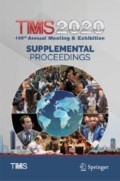Abstract
CoNiCrAl is usually used as the material to bond coat in thermal barrier coatings (TBC) systems under high temperatures. With different amounts of reactive elements Ti and Y added into CoNiCrAl, the effects of their adding on Al2O3 scale spalling resistance are ascertained by examining specimens subjected to cyclic oxidation and isothermal oxidation experiments. The results show that with the same Y content, increasing Ti to 0.3 wt% in the alloy, the scale adherence gets better; however, increasing Ti content to 0.5 wt%, the adherence goes bad. With the same Ti content, when Y in the alloy lowers from 0.4 to 0.1 wt%, the scale adherence improves. As introduced in our previous work, Ti and Y will both participate in the formation and growth of oxide peg, different sizes of oxide pegs, and the interaction between them, and reactive element will bring the different effects on the adherence of the scale.
Access this chapter
Tax calculation will be finalised at checkout
Purchases are for personal use only
References
Chen LC, Zhang C, Yang ZG (2011) Effect of pre-oxidation on the hot corrosion of CoNiCrAlYRe alloy. Corro Sci 53:374–380
Pint BA (2004) The role of chemical composition on the oxidation performance of aluminide coatings. Surf Coat Tech 188–189:71–78
Schumann E (1995) The effect of Y-ion implantation on the oxidation of β-NiAl. Oxid Met 43:157–172
Mennicke C, He MY, Clarke DR, Smith JS (2000) The role of secondary oxide inclusions (“pegs”) on the spalling resistance of oxide films. Acta Mater 48:2941–2949
Tien JK, Pettit FS (1972) Mechanism of oxide adherence on Fe-25Cr-4Al (Y or Sc) alloys. Metall Trans 3:1587–1599
He J, Zhang Z, Peng H, Gong SK, Guo HB (2015) The role of Dy and Hf doping on oxidation behavior of two-phase (γ′+β) Ni-Al alloys. Corro Sci 98:699–707
Acknowledgements
This work was supported by Tsinghua University Initiative Scientific Research Program and the National Magnetic Confinement Fusion Energy Research Project of China (2015GB118001).
The experiments comply with the current laws of the country in which they were performed, and the authors declare that they have no conflict of interest.
Author information
Authors and Affiliations
Corresponding author
Editor information
Editors and Affiliations
Rights and permissions
Copyright information
© 2020 The Minerals, Metals & Materials Society
About this paper
Cite this paper
Yang, L., Zheng, Y., Yang, Z. (2020). Effects of Ti and Y Addition on the Scale Spalling Resistance of CoNiCrAl Alloys. In: TMS 2020 149th Annual Meeting & Exhibition Supplemental Proceedings. The Minerals, Metals & Materials Series. Springer, Cham. https://doi.org/10.1007/978-3-030-36296-6_70
Download citation
DOI: https://doi.org/10.1007/978-3-030-36296-6_70
Published:
Publisher Name: Springer, Cham
Print ISBN: 978-3-030-36295-9
Online ISBN: 978-3-030-36296-6
eBook Packages: Chemistry and Materials ScienceChemistry and Material Science (R0)

